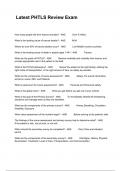Latest
PHTLS
Review
Exam How
many
people
die
from
trauma
annually?
-
ANS
Over
5
million
What
is
the
leading
cause
of
trauma
deaths?
-
ANS
MVA
Where
do
over
90%
of
trauma
deaths
occur?
-
ANS
Low-Middle
income
countries.
What
is
the
leading
cause
of
death
in
people
aged
1-44?
-
ANS
Trauma
What
are
the
goals
of
PHTLS?
-
ANS
Reduce
morbidity
and
mortality
from
trauma,
and
provide
appropriate
care
to
the
patient
in
the
field.
What
is
the
PHTLS
philosophy?
-
ANS
Deliver
the
patient
to
the
right
facility,
utilizing
the
right
mode
of
transportation,
in
the
right
amount
of
time,
as
safely
as
possible.
What
are
the
components
of
scene
assessment?
-
ANS
Safety,
Pre
arrival
information,
arrival
on
scene,
MOI,
and
Patients.
What
is
paramount
for
scene
assessment?
-
ANS
Personal
and
Personnel
safety.
What
is
the
global
view?
-
ANS
What
you
get
before
you
get
out
of
your
vehicle.
What
is
the
goal
of
the
Primary
Survey?
-
ANS
To
immediately
identify
life
threatening
situations
and
manage
them
as
they
are
identified.
What
are
the
components
of
the
primary
survey?
-
ANS
Airway,
Breathing,
Circulation,
Disability,
Exposure
When
does
assessment
of
the
incident
begin?
-
ANS
Before
arriving
at
the
patient's
side.
The
findings
of
the
scene
assessment
and
primary
survey
help
to
determine
what?
-
ANS
If
the
patient
is
sick,
not
yet
sick,
or
not
sick
When
should
the
secondary
survey
be
completed?
-
ANS
Only
if
time
and
situation
permit.
What
are
the
components
of
the
secondary
survey?
-
ANS
Vital
Signs,
History,
Physical
Examination,
Treatment,
Level
of
Care,
Transportation,
and
Communication. What
are
the
components
of
a
radio
report?
-
ANS
Timely,
Scene
Description,
Number
of
Patients,
Current
Patient
Status,
Treatment
Provided,
ETA
What
is
a
tracheal
consideration
with
pediatric
patients
in
regards
to
ETT
intubation?
-
ANS
Potential
for
right
main-stem
intubation.
What
is
the
most
common
cause
of
airway
obstruction
in
the
trauma
patient?
-
ANS
The
tongue.
When
are
basic
maneuvers
applied
in
regards
to
trauma
airway
management?
-
ANS
First
When
are
advanced
airway
maneuvers
performed
for
trauma
patients?
-
ANS
After
basic,
only
if
needed.
What
is
the
goal
of
managing
a
patient's
airway?
-
ANS
Maintain
an
open
and
patent
airway
that
allows
for
adequate
breathing,
ventilation,
and
oxygenation.
What
does
airway
management
entail?
-
ANS
Anticipating
difficulties
and
planning
for
alternate
methods
of
airway
control.
What
is
ALWAYS
the
FIRST
airway
maneuver
for
the
trauma
patient?
-
ANS
Trauma
Jaw
Thrust/Chin
Lift
What
should
be
considered
SECOND
for
maintaining
a
patent
airway
in
the
trauma
patient?
-
ANS
OPA
or
NPA
What
adjunct
should
be
considered
THIRD
for
airway
management
in
the
trauma
patient?
-
ANS
Supra-Glottic
Airways
When
should
glottic
airways
be
considered?
-
ANS
After
jaw
thrusts,
OPA/NPA,
and
SupraGlottic
airways
have
failed.
What
are
some
assessment
criteria
for
Endotracheal
Intubation?
-
ANS
Decreased
LOC
(GCS<8),
Inability
to
maintain
patent
airway,
Upper
Airway
Burns,
Signs
of
pending
airway
obstructions.
Which
type
of
airway
management
should
be
considered
last?
-
ANS
Surgical.
What
types
of
methods
should
be
used
to
verify
tube
placement?
-
ANS
One
physiological
and
one
mechanical
method.
When
the
patient's
breathing
draws
your
attention
you
should...?
-
ANS
Assume
there
is
a
problem
until
proven
otherwise. What
are
some
s/s
you
are
looking
for
in
a
trauma
patient's
breathing
assessment?
-
ANS
Increased
respiratory
effort,
visible
trauma,
paradoxical
chest
wall
movement,
sucking
chest
wound.
What
are
some
s/s
you
are
feeling
for
in
a
trauma
patient's
breathing
assessment?
-
ANS
Bony
crepitus,
subcutaneous
emphysema.
What
is
the
BIGGEST
difference
between
a
simple
and
a
tension
pneumothorax?
-
ANS
A
TENSION
has
a
hemodynamic
compromise.
Which
ribs
are
most
at
risk
for
rib
fracture?
-
ANS
Ribs
4-8
laterally
What
is
the
most
common
cause
of
hemothorax?
-
ANS
Fractures
to
ribs
4-8
What
are
common
complaints
of
rib
fractures?
-
ANS
Pain
and
SOB
Under
what
circumstances
should
you
withhold
oxygen
from
a
patient?
-
ANS
Never
withhold
oxygen
from
a
patient
in
respiratory
distress.
When
should
you
assist
ventilations?
-
ANS
When
the
RR
is
above
28
or
less
than
10.
What
is
the
ventilatory
rate
for
adults?
-
ANS
10-12
bpm
for
500-800cc
What
is
the
ventilatory
rate
for
Children?
-
ANS
16-20
bpm
for
100-500
cc
or
good
chest
rise
What
is
the
ventilatory
rate
for
infants?
-
ANS
25
bpm
for
6-8
ml/kg
What
end
tidal
CO2
reading
should
you
maintain?
-
ANS
35-45
mmHg
Where
should
a
needle
decompression
be
placed?
-
ANS
2nd
intercostal
space
mid
clavicular
line,
over
the
3rd
rib.
What
is
shock?
-
ANS
A
result
of
inadequate
energy
production
to
sustain
life.
What
are
the
brain,
heart,
and
lungs
tolerance
to
hypoxia?
-
ANS
4-6
minutes.
What
are
the
kidneys,
liver,
and
GI
tracts
tolerance
to
hypoxia?
-
ANS
45-90
minutes.
What
are
the
muscle,
bone,
and
skin
tolerance
to
hypoxia?
-
ANS
4-6
hours.
What
is
the
most
common
cause
of
shock
in
the
trauma
patient?
-
ANS
Hypovolemia
due
to
hemorrhage
until
proven
otherwise.




